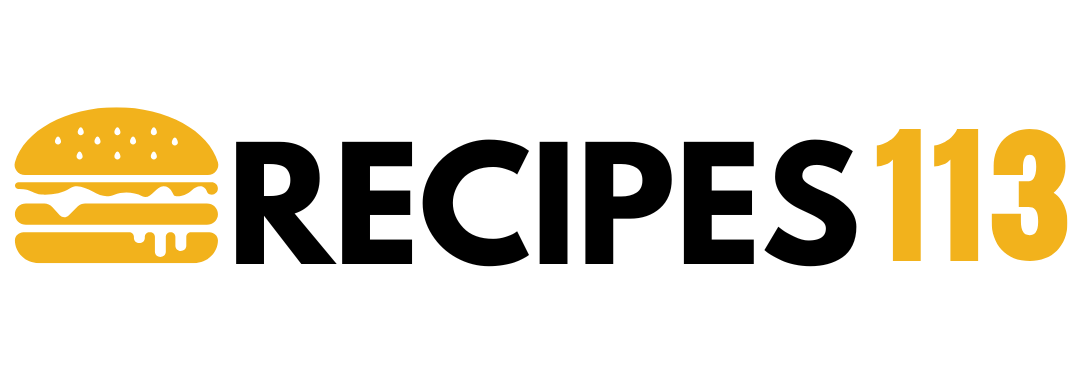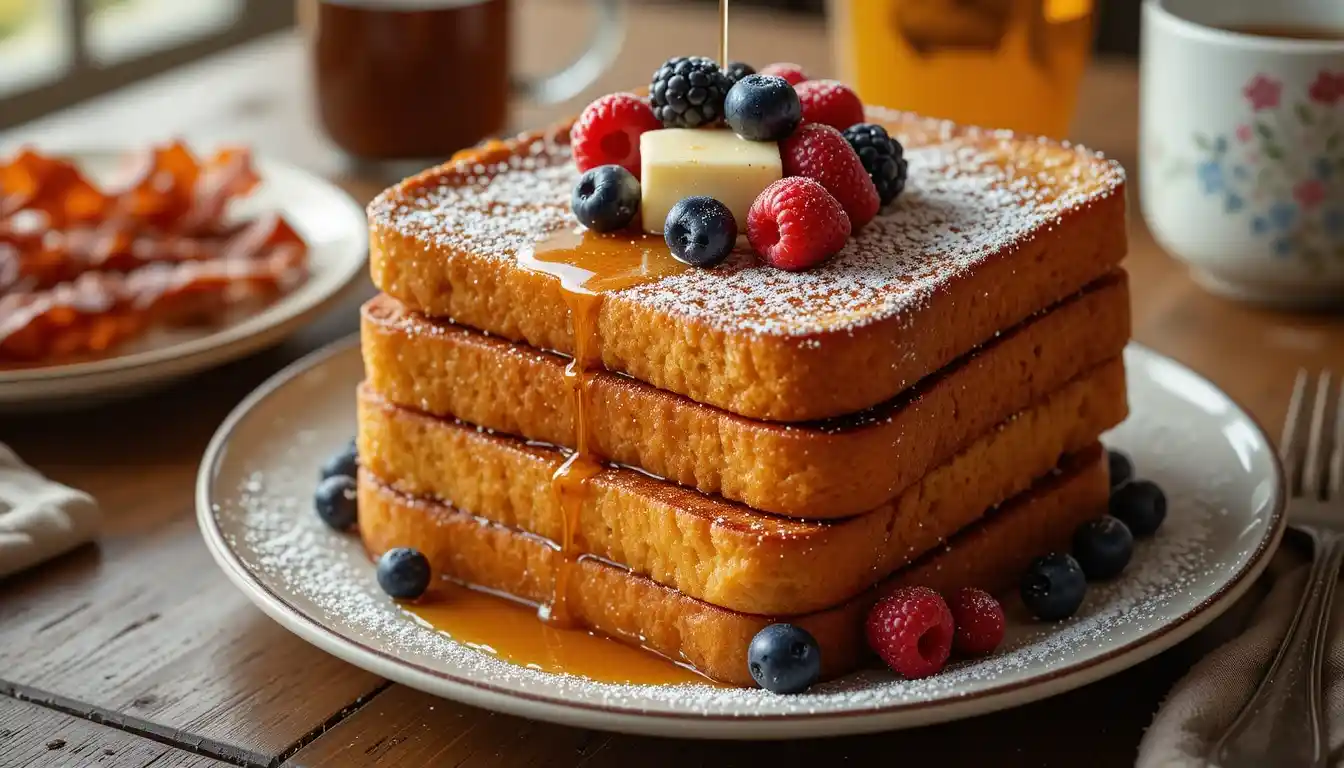Table of Contents
Imagine starting your day with a decadent breakfast that’s both simple to make and impressive to serve. Fluffy French toast is a classic dish that has stood the test of time, and with this easy recipe, you can enjoy a restaurant-quality breakfast at home.
This French toast recipe stands out from the rest with its thicker batter and cinnamon sugar flavors, making it a family favorite. The combination of milk, eggs, and other ingredients creates a tender and golden-brown exterior that’s sure to please.
By the end of this article, you’ll have all the knowledge needed to make this delicious breakfast dish, perfect for both special occasions and everyday mornings.
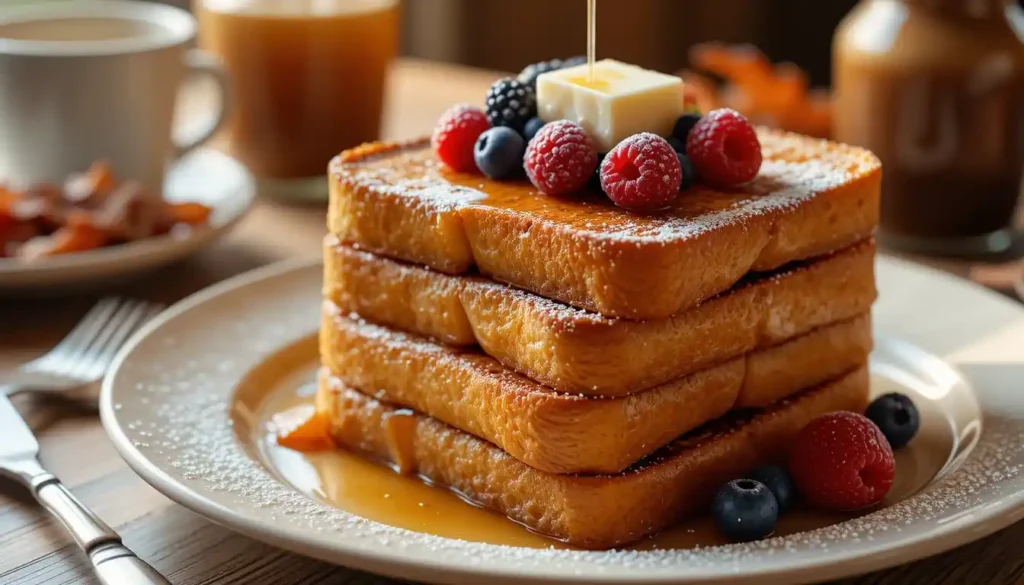
The Secret to Perfectly Fluffy French Toast
The secret to making French toast irresistibly fluffy lies in its batter. Adding flour to the egg mixture creates a thicker batter that coats the bread more effectively.
This technique is crucial for achieving restaurant-quality French toast at home. The flour helps create a protective coating that traps moisture inside the bread while creating a crisp exterior. To make the perfect batter, mix flour and eggs first, then add milk and other ingredients.
- Avoid common mistakes like not mixing ingredients thoroughly.
- Use the right ratio of eggs to milk to flour for optimal fluffiness.
- The batter should be thick but still pourable.
This technique works with various types of bread, making it a versatile recipe for any ingredient.
Essential Ingredients for the Best French Toast Recipe
The foundation of great French toast lies in its ingredients. The right components can elevate this breakfast dish to a whole new level.
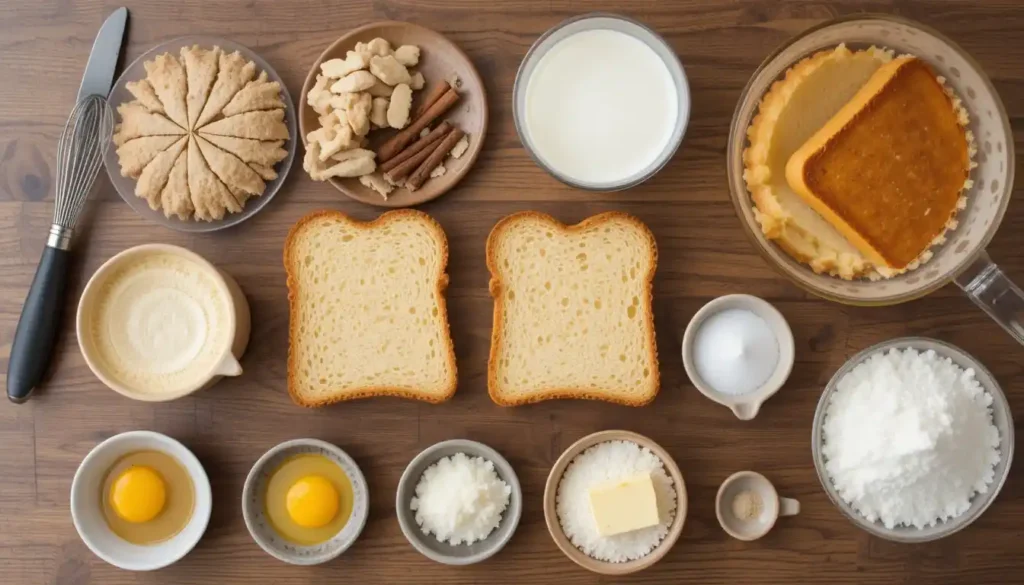
When it comes to making exceptional French toast, the type of bread used is crucial. The ideal bread should be sturdy enough to absorb the egg mixture without falling apart.
Best Bread Choices for French Toast
For the best results, use thick slices of bread, such as brioche, challah, or Texas toast. Bread slices that are around 3/4 to 1 inch thick work best as they absorb the batter well. Day-old or slightly stale bread is also recommended as it yields a better texture.
- Brioche and challah provide a rich, tender crumb.
- Texas toast offers a soft, slightly sweet base.
- Cinnamon bread adds a warm, spicy flavor.
For those requiring gluten-free options, there are several bread alternatives that can produce satisfying results. Avoid using very thin sandwich slices as they tend to become soggy.
| Bread Type | Texture | Flavor |
|---|---|---|
| Brioche | Rich, tender | Buttery |
| Challah | Soft, dense | Slightly sweet |
| Texas Toast | Soft | Mildly sweet |
Equipment You’ll Need
To make the perfect French toast, you’ll need the right equipment. Essential items include a shallow dish for the batter, a whisk or blender, a griddle or skillet, and a spatula.
- A griddle offers more cooking surface for multiple slices, making it ideal for larger batches.
- Preheat your griddle to 350 degrees F or heat a skillet over medium heat.
- Use a spatula that’s the right size to cook and flip your toast without breaking it.
Optional equipment like a blender for mixing the batter or a warming drawer to keep cooked slices warm can enhance the process. Having all equipment ready before starting ensures efficiency.
Step-by-Step French Toast Recipe
To create the perfect French toast, follow this simple step-by-step guide. This recipe will walk you through preparing the batter, cooking the toast to a golden brown perfection, and determining when it’s done just right.
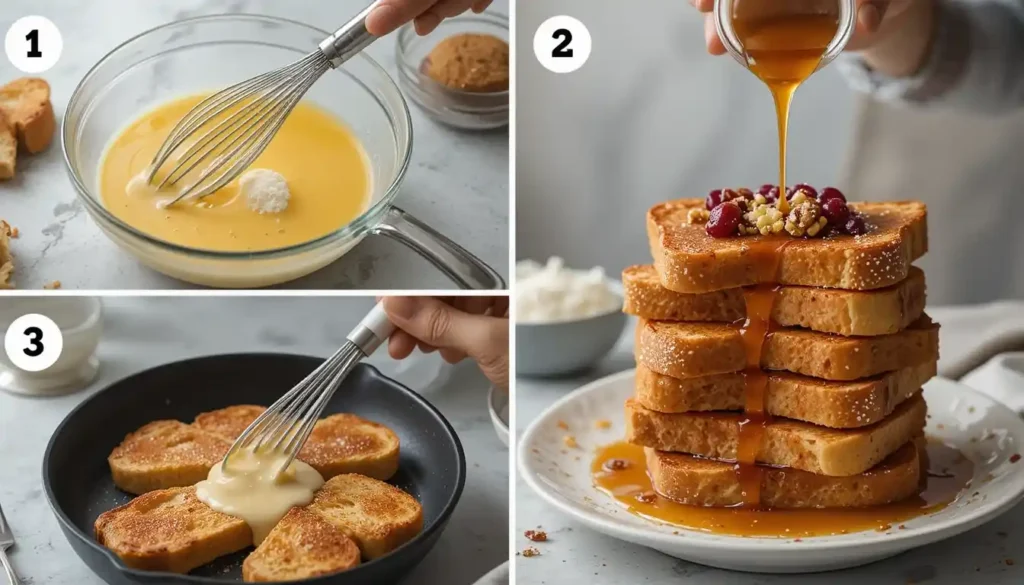
Preparing the Batter
Start by whisking together eggs, milk, and a pinch of salt in a shallow dish. The mixture should be smooth and well combined. Add a hint of cinnamon or vanilla extract for extra flavor if desired. This batter will be the foundation of your French toast, so ensure it’s mixed thoroughly.
Dipping and Cooking Technique
Heat a non-stick skillet or griddle over medium heat. Dip each slice of bread into the batter, coating both sides evenly. Place the bread on the skillet and cook for a few minutes until the bottom starts to get golden brown. Flip and cook on the other side the same.
How to Tell When French Toast is Done
French toast is done when it’s golden brown on both sides and slightly puffed. To check for doneness, gently press the center; it should spring back slightly. The time it takes to cook French toast can vary based on the bread’s thickness and type. For absolute certainty, use a food thermometer to ensure the internal temperature reaches 165°F.
| Cooking Indicator | Description |
|---|---|
| Visual Cues | Golden brown color on both sides, slightly puffed |
| Texture Check | Spring back slightly when pressed gently in the center |
| Internal Temperature | 165°F for egg safety |
Pro Tips for Fluffy French Toast Success
Achieving perfectly fluffy French toast is easier than you think with these simple pro tips. The key to a great French toast lies in its preparation and the quality of its ingredients. Using the right bread and not over-soaking it in the batter are crucial.
Make-Ahead and Storage Options
To save time in the morning, you can prepare certain components of your French toast ahead. The batter can be made 1-2 days in advance and refrigerated in an airtight container. Cooked French toast can be cooled, stored in freezer-safe bags, and reheated when needed. You can reheat it in a skillet, toaster, or microwave. Drizzle with maple syrup just before serving for the best flavor.
For larger groups, consider making a French toast casserole the night before. This not only saves time but also ensures everyone gets a warm, delicious breakfast. Always check your stored French toast or batter for freshness before consuming.
Delicious Serving Suggestions and Variations
Take your French toast to the next level by experimenting with different serving suggestions and variations. For a classic take, top your french toast with maple syrup and a sprinkle of powdered sugar. You can also add a dollop of whipped cream or a handful of fresh berries for added flavor and texture.
For a more decadent treat, try making stuffed French toast with a cream cheese or Nutella filling. Alternatively, you can create a savory version by topping your toast with herbs, cheese, and crispy bacon. To complement your French toast, consider serving it with a side of bacon, sausage, or fresh fruit.
To add a seasonal twist, top your French toast with caramelized apples in the fall or fresh peaches in the summer. Creating a French toast bar for brunches allows guests to customize their own servings with various toppings. This interactive approach makes for a fun and memorable breakfast experience.
Why This Will Become Your Go-To Breakfast
Discover why this French toast recipe will be your new go-to breakfast favorite. With its simple preparation and impressive results, it’s perfect for both everyday breakfast and special occasions. This recipe offers a great balance of nutrition, providing protein and the option to use whole grain bread for added fiber. It’s also versatile, allowing for various adaptations to suit different dietary needs.
With only 91 calories per serving, this French toast is a guilt-free treat. The basic recipe opens the door to countless variations, encouraging you to experiment with different breads, spices, and toppings. We invite you to make this recipe your own and share your results and variations in the comments section.
FAQ
What type of bread is best for making fluffy French toast?
Thick slices of brioche or challah bread work best, as they absorb the egg mixture well and yield a tender, fluffy interior.
Can I use low-fat milk instead of whole milk for the egg mixture?
While whole milk provides richness, you can use low-fat or non-dairy milk alternatives, but the French toast might be slightly less creamy.
How do I prevent my French toast from becoming too soggy?
To avoid sogginess, cook the French toast over medium heat, and don’t over-soak the bread slices in the egg mixture.
Can I make French toast ahead of time and reheat it?
Yes, you can make French toast ahead and reheat it in a toaster or toaster oven. However, it’s best consumed fresh for optimal texture.
What are some creative topping ideas for French toast?
Try topping your French toast with maple syrup, powdered sugar, fresh fruit, whipped cream, or even caramelized bananas for a delicious twist.
Is it necessary to add vanilla extract to the egg mixture?
While not necessary, vanilla extract adds a subtle, sweet flavor that enhances the overall taste of the French toast.
Can I use a non-stick skillet for cooking French toast?
Yes, a non-stick skillet is a great option for cooking French toast, as it prevents the bread from sticking and makes cleanup easier.
